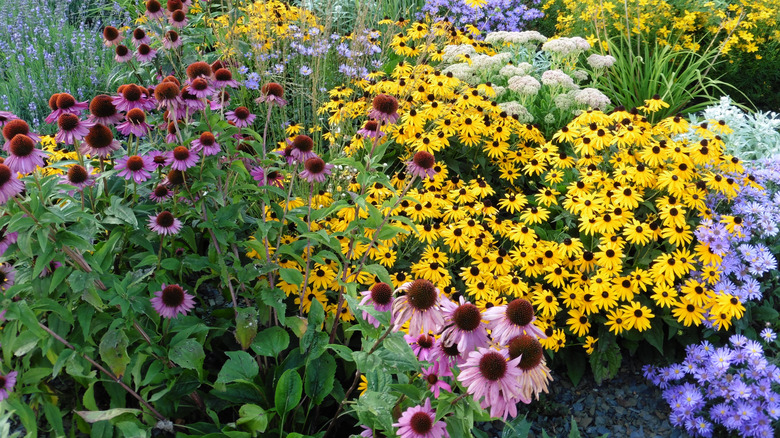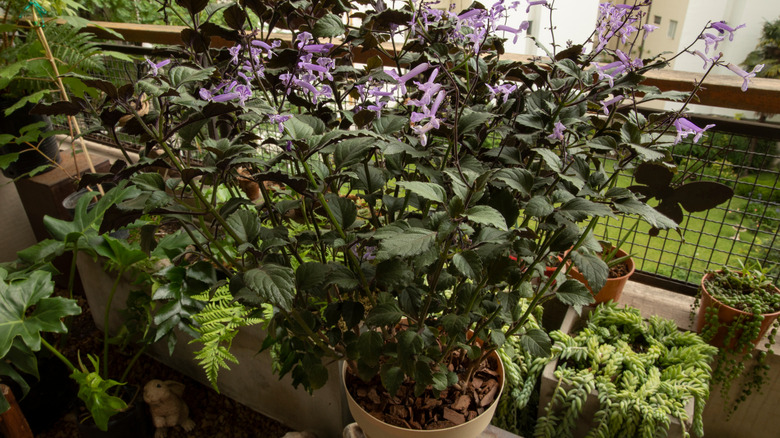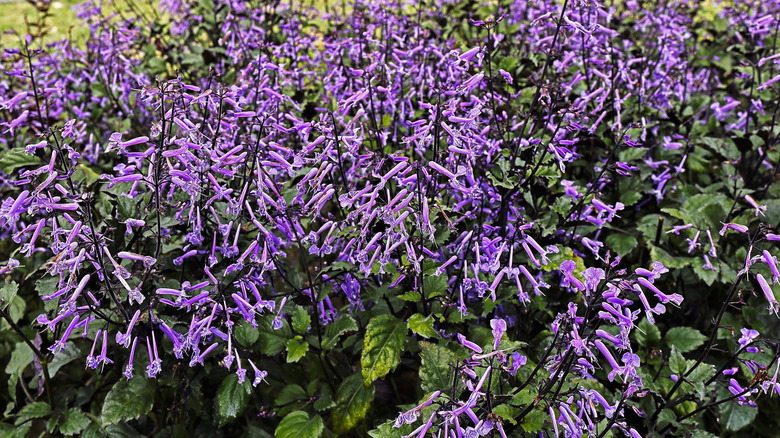The Low-Maintenance Perennial That Blooms Indoors And Out
Have you ever wondered how wonderful it would be if a plant flowered both indoors and out, sparing you decision fatigue? Turns out, Plectranthus 'Mona Lavender', does just that. "The 'Mona Lavender' cultivar of Plectranthus can be successfully grown as both a houseplant and a perennial outdoors in frost-free climates," explains Rhonda Kaiser, author of "The Vintage Farmhouse Garden" and owner of Southern Home and Farm, in her exclusive interview with House Digest. This heat- and drought-resistant plant delivers months of striking purple blooms, whether planted in borders, patio containers, or indoor planters, with surprisingly little care.
The notable difference, however, is that 'Mona Lavender' flowers differently based on its location. "Indoors, it prefers bright, indirect light and tends to bloom in winter and autumn," says Kaiser. Owing to lower light levels and steady temperatures, she notes that 'Mona Lavender' doesn't flower as bountifully as it would outside. But if given the right lighting, this houseplant may extend its flowering season into spring. Contrarily, when cultivated in flower gardens, this purple plant shifts its flowering season earlier into the summer. "Outdoors, it thrives in partial shade and blooms profusely from late summer through autumn, with cool nights and natural light cycles enhancing flower production," she adds. Unfortunately, since protection from hard frosts is essential, such year-round planting is only possible in USDA zones 9b to 11. Everywhere else, you may either grow it as an annual or pot it up and let it overwinter inside.
Growing 'Mona Lavender' as a houseplant
In areas where winter temperatures dip below 20 degrees Fahrenheit — zones 9a and colder — 'Mona Lavender' can't survive outside throughout the year. In these regions, Kaiser believes popping this perennial in containers is an effective technique to enjoy a more perennial-esque experience. Explaining this in her exclusive House Digest interview, she states, "... some gardeners grow it in pots just so it can be brought inside before the first frost, preserving the plant for the following year." Granted, the conditions aren't as amenable to flowering indoors. But "this container technique allows the plant to be grown year-round, and it will often come back even more vigorously and bloom more when replanted in the spring outdoors," elaborates Kaiser.
But don't let the containers dim the dazzle on your 'Mona Lavender' plants. Kaiser has some neat tricks to improve their flowering quality. "To lengthen flowering and intensify blooms, make the plant experience shorter daylengths in autumn and winter by limiting late-evening exposure to artificial lighting." In essence, such a reduction in light exposure mimics natural seasonal progression, coaxing the plant into growing new blooms. Deadheading spent blooms should also encourage reblooming, as should lightly pinching back the stems after the first flush, because it stimulates the production of new branches, and, by extension, more flower spikes. "Lastly, keep the plant at 60-75°F temperatures, and away from heating vents or draft windows, as a consistent, moderate temperature helps to keep the plant healthy and prolong the time of blooming in the home," she asserts.
Growing 'Mona Lavender' in garden beds
If you live in zones 9b to 11, where winters are mild and frost-free, you can successfully grow 'Mona Lavender' in your garden beds and borders. As for the growth conditions, Kaiser tells House Digest exclusively that you must give the plant a "site with partial sun, such as morning sun and afternoon shade, as this mix allows for healthy growth with protection of the leaves from burning." In short, don't be afraid to move the perennial into a shaded site if your garden experiences extremely hot conditions. Since this low-maintenance perennial is partial to moist soils but can rot if left standing in water for too long, she advised to "plant 'Mona Lavender' in well-established, quick-draining soil and mix in compost to add water-holding capacity and fertility." You may also mulch the beds for improved water retention, to cool the roots, and keep weeds down.
If you want to enjoy the blooms for as long as possible, Kaiser suggests that you deadhead these flowering plants for maximum blooms. This works because the plant is forced to redirect its energy from seed production to growing new flowers. Like for houseplants, pinching or pruning post-flowering is equally helpful. "Early spring and mid-summer feeding with balanced, slow-release fertilizer will also stimulate vigorous flowering," adds Kaiser. "Lastly, give good air circulation to prevent mildew and other fungal diseases, which can cause interruption in flowering as well as overall health."


